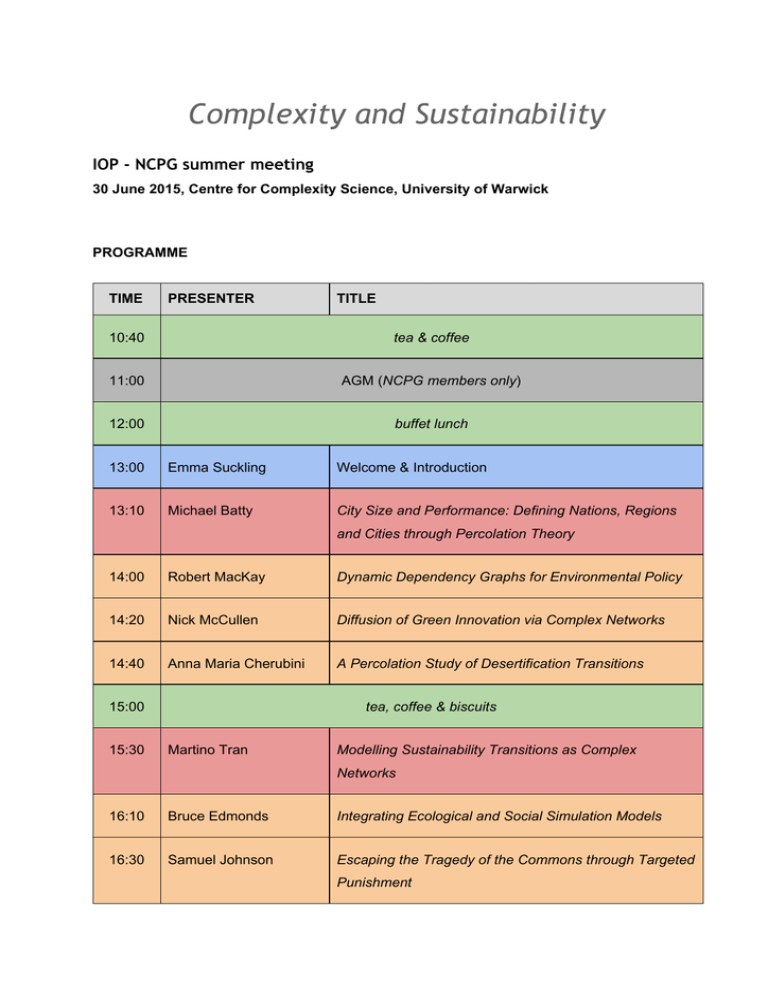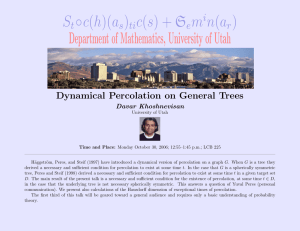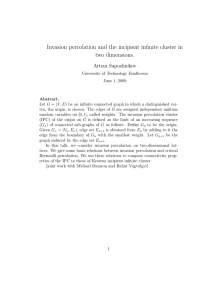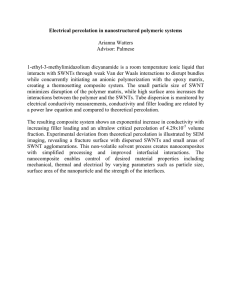Complexity and Sustainability IOP - NCPG summer meeting
advertisement

Complexity and Sustainability IOP - NCPG summer meeting 30 June 2015, Centre for Complexity Science, University of Warwick PROGRAMME TIME PRESENTER TITLE 10:40 tea & coffee 11:00 AGM ( NCPG members only) 12:00 buffet lunch 13:00 Emma Suckling Welcome & Introduction 13:10 Michael Batty City Size and Performance: Defining Nations, Regions and Cities through Percolation Theory 14:00 Robert MacKay Dynamic Dependency Graphs for Environmental Policy 14:20 Nick McCullen Diffusion of Green Innovation via Complex Networks 14:40 Anna Maria Cherubini A Percolation Study of Desertification Transitions 15:00 15:30 tea, coffee & biscuits Martino Tran Modelling Sustainability Transitions as Complex Networks 16:10 Bruce Edmonds Integrating Ecological and Social Simulation Models 16:30 Samuel Johnson Escaping the Tragedy of the Commons through Targeted Punishment Michael Batty ● City Size and Performance: Defining Nations, Regions and Cities Through Percolation Theory Bio Michael Batty is Bartlett Professor of Planning at University College London where he is Chair of the Centre for Advanced Spatial Analysis (CASA). He has worked on computer models of cities and their visualisation since the 1970s and has published several books, such as Cities and Complexity (MIT Press, 2005) which won the Alonso Prize of the Regional Science Association in 2011, and most recently The New Science of Cities (MIT Press, 2013). His blogs www.complexcity.info cover the science underpinning the technology of cities and his posts and lectures on big data and smart cities are at www.spatialcomplexity.info . His research group is working on simulating long term structural change and dynamics in cities as well as their visualisation. Prior to his current position, he was Professor of City Planning and Dean at the University of Wales at Cardiff and then Director of the National Center for Geographic Information and Analysis at the State University of New York at Buffalo. He is a Fellow of the British Academy (FBA) and the Royal Society (FRS), was awarded the CBE in the Queen’s Birthday Honours in 2004, the 2013 recipient of the Lauréat Prix International de Géographie Vautrin Lud, and the Founders Medal of the Royal Geographical Society in 2015. Abstract Defining urban and regional phenomena in spatial terms of riddled with difficulties. The ecological fallacy has been known for 75 years or more, but recently the problem has emerged again in the debate concerning how cities perform economically as they get bigger. It has been supposed and sometimes demonstrated that as cities get bigger, some indicators such as income, patents crime, and inequality scale super­linearly with size, suggesting that cities are more productive and innovative the larger they are but also more hostile and unfair in their distribution of wealth and comparative advantage. In Britain, we have found however that cities do not grow in terms of their wealth as they get bigger. London of course does as it is a massive outlier but all the other cities simply scale in proportion to their size. This of course begs the question as whether or not Britain is an outlier when it comes to these kinds of agglomeration economies or whether or not it is because the urban system is much more highly integrated than other systems of cities. We assume the latter. To explore these ideas, we use percolation theory to define the boundaries of cities, starting from the giant cluster formed by the street network for England, Wales and Scotland and then thresholding this at different levels to produce a unique decomposition in terms of connectivity. The data is very fine scale with street intersections at a resolution of 100 metres or less and thus our analysis produces a hierarchical clustering the British space from 5km down to 50m. When we do this we not only define cities but also the nations that compose Britain, its regions, and then its cities. There are some very surprising results of doing this for historically the relative independence of Scotland immediately emerges, the north­south divide, the Welsh periphery, the southern Cornish Peninsula, Lincolnshire and the Wash, all places with their own identities. I will say more here but you can see the video at the link below http://www.mechanicity.info/percolation­clustering­of­the­uk­road­network/ preprints at: http://arxiv.org/abs/1505.00217 http://arxiv.org/abs/1504.08318 Robert MacKay (University of Warwick) ● Dynamic dependency graphs for environmental policy In evaluating proposed environmental policy it is important to estimate the interdependency between the dynamics of the relevant agents. For a simple class of stochastic systems, which can include time inhomogeneity, if the interdependence is weak then the statistical outcome is unique and varies smoothly with parameters. In contrast, if it is strong then the outcome may depend on the initial conditions and the realisation, and may exhibit jumps as parameters are varied. Nick McCullen (University of Bath) ● Diffusion of Green Innovation via Complex Networks End use energy efficiency is increasingly important, via the uptake of either new technologies or less wasteful behaviours. Decisions to adopt a particular product or practice are based on a combination of factors: a) rational decision­making with regards to the intrinsic value to the individual; b) social spreading of technology or ideas induced by peer­to­peer communication of information; c) interaction with the system average via a media or other feedback. For certain innovative technologies or behaviours the decision to adopt may be based on a combination of these factors. This is particularly the case for energy­related innovations, where some are more visible and socially desirable (such as solar panels) compared to others which are hidden (such as home insulation). This talk describes a threshold model for the dynamics of the adoption of such innovations via communication over complex interpersonal networks. These models are based on a combination of all three of the above factors, along with dynamical­systems inspired methods for analysing and understanding the numerically observed diffusion behaviour. Anna Maria Cherubini (University of Salento, Italy) ● A percolation study of desertification transitions (Joint work with Raffaele Corrado and Cecilia Pennetta) We present the results of a theoretical study on transition to desertification in semi­arid ecosystems, aimed at identifying early­warning signals for the transition. The study is based on numerical simulations of a stochastic cellular automaton model for semi­arid ecosystems recently introduced in literature. The results are analysed in terms of percolation theory, focussing in particular on the role played by the mortality rate , related to the strength of external stresses acting on the system. For increasing values of the mortality rate , we could follow the increasing degradation through different stages, characterised by different connectivity properties. In order to find indicators and precursors of the different stages of deterioration, we calculated the spanning probabilities and the percolation thresholds as functions of according to different spanning criteria and we studied the time fluctuations of the sizes of the biggest vegetation cluster and the biggest non­vegetated cluster over the range of mortality values. Martino Tran ● Modelling Sustainability Transitions as Complex Networks Bio Martino is Assistant Professor in the School of Community and Regional Planning, Faculty of Applied Sciences, University of British Columbia, and Associate at the Environmental Change Institute, University of Oxford. He is broadly interested in general theory and methods for understanding and managing risk and sustainability in the built environment. This includes the application of systems theory, techno­economic analysis, stochastic dynamical systems, and complex networks to assess the long­term performance of large­scale engineering systems and technologies. Martino completed his DPhil in Environmental Science and Engineering as an Oxford Martin Fellow in collaboration with Engineering Sciences and the School of Geography and Environment, University of Oxford. Abstract The dynamics between agent behaviour and technological systems underpin and impact upon many processes in society and nature. Although this involves diverse phenomena their mathematical description relies on similar dynamical systems models that characterize heterogeneous agent interactions on physical, technological and social networked systems. Conventionally, technological and behavioural systems are analysed as separate entities. Here, we discuss the potential for more integrated modelling approaches that combine mean­field and agent based models to assess the future impacts of technology on society and environment. Recent work will be presented using complex network theory to assess sustainability across multiple scales including risk and resilience in urban technological networks, along with social influence on the adoption of new energy saving technologies. The potential and limits to some of these analyses will be discussed, along with suggesting that improving our ability to assess and predict sustainability transitions using complexity theory can help avoid systems lock­in and inform a wider range of adaptive responses to environmental and societal risk. Bruce Edmonds (Centre for Policy Modelling, Manchester Metropolitan University) ● Integrating ecological and social simulation models Whilst ecological and social systems are separately complex, it is the interaction between these two systems that is key to understanding the impact human society can have on species diversity. An individual­based simulation that integrates ecological and human­social elements is presented. In this simulation, the ecology is represented by individuals and species that evolve over time, resulting in complex and dynamic food chains (if the conditions are right). The simulation is run for a period until such an ecology is built up, and then (optionally) a society of humans injected and the simulation continued. This allows for the longer­term impact of humans upon different ecologies to be explored and the complex interactions between social and ecological systems to be identified. Samuel Johnson (University of Warwick) ● Escaping the Tragedy of the Commons through Targeted Punishment Failures of cooperation cause many of society’s gravest problems. It is well known that cooperation among many players faced with a social dilemma can be maintained thanks to the possibility of punishment, but achieving the initial state of widespread cooperation is often much more difficult. I will discuss recent work describing strategies of 'targeted punishment' whereby a small number of punishers can shift a population of defectors into a state of global cooperation [1]. I will conclude by outlining how the international community might use a strategy of this kind to combat climate change. [1] S. Johnson, Escaping the Tragedy of the Commons through Targeted Punishment, arXiv:1506.01508 (2015)






